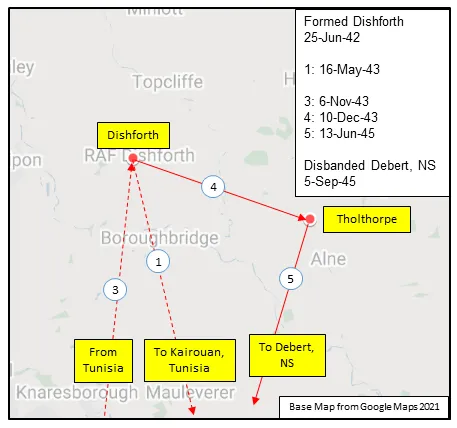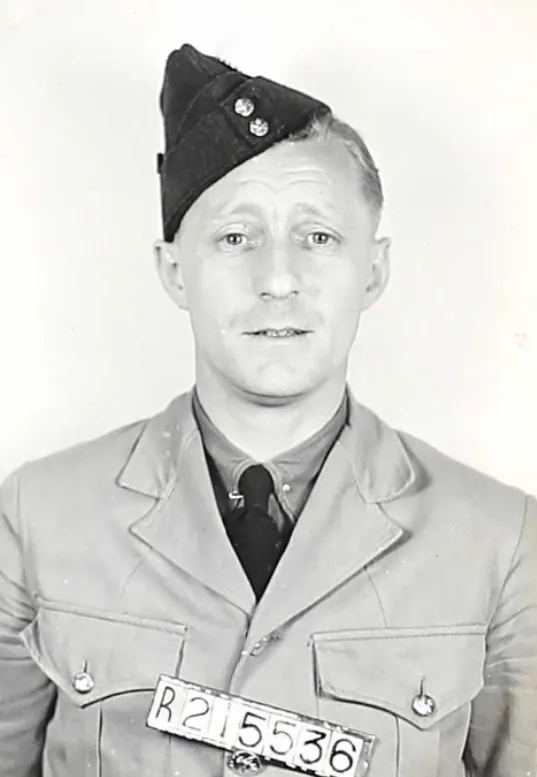Poulos, Paul
Killed in Action 1944-07-29


Birth Date: 1924
Born:
Son of Denis and Margaret Poulos, of Toronto, Ontario, Canada.
Home: Toronto, Ontario
Enlistment:
Enlistment Date: Unknown
Service
RCAF
Unit
425 (B) Sqn- Squadron
Je te plumerai I shall pluck you
Base
RAF Tholthorpe
Rank
Pilot Officer
Position
Pilot Officer
Service Numbers
J/90954
Prev: R/212669
Home
 Toronto, Ontario
Toronto, Ontario
Target
 Hamburg Germany
Hamburg Germany
First Burial
 Runnymede Memorial Surrey, Uk
Runnymede Memorial Surrey, Uk
Pilot Officer P Poulos (RCAF) was missing, presumed killed in action
Pilot Officer Poulos has no known grave and is commemorated on the Runnymede War Memorial
Halifax B.Mk.III MZ641
Bombing Hamburg Germany 1944-July-29 to 1944-July-29
(B) Sqn (RCAF) Tholthorpe
Battle of Normandy
307 aircraft - 187 Halifaxes, 106 Lancasters, 14 Mosquitoes - from 1, 6 and 8 Groups. German fighters again appeared, this time on the homeward flight, and 18 Halifaxes and 4 Lancasters were lost, 7.2 per cent of the force. The Halifax casualties were 9.6 per cent; 431 (Canadian) Squadron, flying from Croft airfield in Co. Durham, lost 5 of its 17 aircraft on the raid.
This was the first heavy raid on Hamburg since the Battle of Hamburg just a year earlier. The bombing on this raid was not well concentrated. The Germans estimated that only 120 aircraft bombed in the city area, with no recognizable aiming point, though western and harbour areas received the most bombs. A large proportion of the attack fell on areas devastated in 1943 but 265 people were killed and more than 17,000 had to be evacuated from homes damaged in this raid, many of which were probably only temporary wooden accommodation at this stage of the war. Brunswig (p. 339) describes how a panic developed at the large Reeperbahn air-raid shelter when a lone aircraft came in to bomb after the all clear had sounded and nearby Flak guns opened fire. 2 women were trampled to death and others were badly hurt.
source: The Bomber Command War Diaries, Martin Middlebrook and Chris Everitt
Halifax MZ641
Handley Page Halifax

The Handley Page Halifax is a British Royal Air Force (RAF) four-engined heavy bomber of the Second World War. It was developed by Handley Page to the same specification as the contemporary twin-engine Avro Manchester.
The Halifax has its origins in the twin-engine HP56 proposal of the late 1930s, produced in response to the British Air Ministry's Specification P.13/36 for a capable medium bomber for "world-wide use." The HP56 was ordered as a backup to the Avro 679, both aircraft being designed to use the underperforming Rolls-Royce Vulture engine. The Handley Page design was altered at the Ministry to a four-engine arrangement powered by the Rolls-Royce Merlin engine; the rival Avro 679 was produced as the twin-engine Avro Manchester which, while regarded as unsuccessful mainly due to the Vulture engine, was a direct predecessor of the famed Avro Lancaster. Both the Lancaster and the Halifax would emerge as capable four-engined strategic bombers, thousands of which would be built and operated by the RAF and several other services during the War.
On 25 October 1939, the Halifax performed its maiden flight, and it entered service with the RAF on 13 November 1940. It quickly became a major component of Bomber Command, performing routine strategic bombing missions against the Axis Powers, many of them at night. Arthur Harris, the Air Officer Commanding-in-Chief of Bomber Command, described the Halifax as inferior to the rival Lancaster (in part due to its smaller payload) though this opinion was not shared by many of the crews that flew it, particularly for the MkIII variant. Nevertheless, production of the Halifax continued until April 1945. During their service with Bomber Command, Halifaxes flew a total of 82,773 operations and dropped 224,207 tons of bombs, while 1,833 aircraft were lost. The Halifax was also flown in large numbers by other Allied and Commonwealth nations, such as the Royal Canadian Air Force (RCAF), Royal Australian Air Force (RAAF), Free French Air Force and Polish forces.Wikipedia
 National Air Force Museum of Canada
National Air Force Museum of Canada
425 (B) Sqn Je te plumerai ("Alouette")
History of the Squadron during World War II (Aircraft: Wellington III, X, Halifax III, Lancaster X)

425 Squadron was formed at Dishforth, Yorkshire, UK on June 25, 1942 as the RCAF's twenty-second squadron, and fifth bomber squadron, to be formed overseas in WWII. At the time it was part of No 4 Group, RAF Bomber Command. It was unique in being designated "French-Canadian" and every effort was made to find French Canadian airmen elsewhere in Bomber Command who could be transferred to the squadron. It became operational in October, 1942, flying Wellington Mk III aircraft with the squadron code letters KW. It transferred to No 6 (RCAF) Group, Bomber Command when that was formed on January 1, 1943, although remaining at Dishforth. In March, the squadron re-equipped with Wellington X's and from June to October operated from bases in Tunisia (Kairouan/Zina and Hani East airfields) in support of the Allied invasions of Sicily and Italy. In November 1943 the squadron returned briefly to Dishforth and re-equipped with Halifax III aircraft before moving to Tholthorpe, Yorkshire in December, as part of No 62 (RCAF) Base of 6 Group. It remained at Tholthorpe until the end of the war in Europe. In May and June of 1945 it re-equipped with Lancaster X aircraft, in preparation for joining the Tiger Force for attacks on Japan. The surrender of Japan caused the disbandment of the Squadron at Debert, Nova Scotia , on September 5, 1945.
Overall, the squadron flew 328 missions, involving 3694 sorties, in the course of which 9152 tons of bombs were dropped and 55 aircraft were lost. Squadron personnel gained 2 MBE's, 63 DFC's and 4 Bars to DFC, 2 GM's, 18 DFM's, 1 DFC(USA), and 4 MiD's. Battle Honours were:English Channel and North Sea 1943-45, Baltic 1944-45, Fortress Europe 1943-44, France and Germany 1944-45, Biscay Ports 1943-44, Ruhr 1943-45, Berlin 1944, German Ports 1943-45, Normandy 1944, Rhine, Biscay 1943-44, Sicily 1943, Italy 1943, Salerno. Wikipedia, Moyes, Kostenuk and Griffin
Squadron History (Bomber Command Museum PDF)
Maps for Movements of 425 Squadron 1942-45
 MAP 1: 425 Squadron Movements 1942-45 (right-click on image to display enlarged in new tab) |  MAP 2: 425 Squadron Movements 1942-45 (detail of Map 1) |  MAP 3: 425 Squadron Movements in North Africa 1943 |

425 Squadron History Summary 1942-45

425 Squadron History Summary 1942-45 Page 2

History of the Squadron Post-WWII (Aircraft: Canuck, Voodoo, Hornet)
The squadron was re-formed as an All-Weather (Fighter) unit at St Hubert (Montreal), Quebec on 1 October 1954. It flew CF-100 Canuck aircraft on North American air defence. Selected as one of five units to be re-equipped with CF-101 (Voodoo) aircraft, it was deactivated on 1 May 1961 pending delivery of the aircraft. Reactivated at Namao (Edmonton), Alberta on 15 October 1961, the squadron initially received the trainer version of the CF-101 and served as a training unit to convert the remaining four squadrons to this aircraft. It afterwards moved to Bagotville, Quebec, in July 1962, and was declared operational on 1 October when No. 3 All-Weather (Fighter) Operational Training Unit assumed responsibility for all future CF-101 training. On 1 February 1968 the squadron was integrated into the Canadian Armed Forces. From 1982, the Canadian Forces started to acquire CF-18 Hornets; 425 Sqn received them in 1985. In 2005, 433 Squadron was merged into 425 Squadron. 425 Tactical Fighter Squadron is an integral part of NORAD and of the North Atlantic Treaty Organization (NATO). In peacetime, the squadron's fighters provide continuous surveillance of the East Coast of Canada. In addition, it must be ready for rapid deployment anywhere in the world in support of NATO or contingency operations.Wikipedia, Kostenuk & Griffin, and www.canada.ca/en/air-force/corporate/squadrons/425-squadron.html
 Canadian Virtual War Memorial
Canadian Virtual War Memorial







 Halifax Heavy Bomber WWII
Halifax Heavy Bomber WWII Harold A Skaarup Web Page
Harold A Skaarup Web Page Wikipedia Halifax Bomber
Wikipedia Halifax Bomber